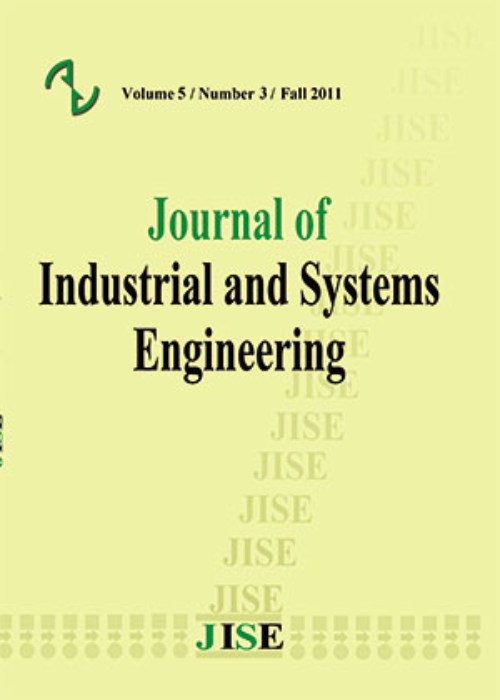فهرست مطالب
Journal of Industrial and Systems Engineering
Volume:12 Issue: 1, Winter 2019
- تاریخ انتشار: 1397/11/07
- تعداد عناوین: 4
-
-
Pages 1-14
A profile is a relationship between a response variable and one or more independent variables being controlled during the time. Process Capability Indices (PCI) are measured to evaluate the performance of processes in producing conforming products. Despite frequent applications of profile and a variety of available methods to monitor its different types, little researches have been carried out on determining capability indices of profile process. PCIs such as and in profile state, are used to evaluate process capability in producing conforming profiles. This paper presents a functional approach for nonlinear profiles which usually expressed as nonlinear regression. Thus, functions such as pertaining technical specification limits, mean and natural tolerance limits are determined as nonlinear profiles and also functional limit is applied to determine Functional Capability Indices (FCI) and of functional nonlinear profile. Easy calculation and the ability to calculate FC in each period and at each point are from the advantages of this method over the other methods.
Keywords: Profile monitoring, non-linear profile, functional process capability index, vertical density profile -
Pages 15-34
In some statistical process monitoring applications, quality of a process or product is described by more than one ordinal factors called ordinal multivariate process. To show the relationship between these factors, an ordinal contingency table is used and modeled with ordinal log-linear model. In this paper, a new control charts based on ordinal-normal statistic is developed to monitor the ordinal log-linear model based processes in Phase II. Performance of the proposed control chart is evaluated through simulation studies and a real numerical example. In addition, to show the efficiency of ordinal-normal control chart, performance of the proposed control chart is compared with an existing Generalized-p </em>chart. Results show the better performance of the proposed control chart in detecting the out-of-control condition.
Keywords: Statistical process monitoring, ordinal contingency table, ordinalnormal control chart, Phase II -
Pages 35-65
Most of the inventory control models assume that quality defect never happens, which means production process is perfect. However, in real manufacturing processes, the production process starts its operation in the in-control state; but after a period of time, shifts to the out-of-control state because of occurrence of some disturbances. In this paper, in order to approach the model to real manufacturing conditions, a process is considered in which quality defect and machine deterioration may occur. Since the adaptive control charts detect the occurrence of assignable cause quicker than the traditional control charts, an adaptive non-central chi-square control chart is designed, which monitors the process mean and variance, simultaneously. In addition, to reduce the failure rate of the machine, two types of maintenance policies consisting of reactive and preventive are planned. Then, the particle swarm optimization algorithm is employed to minimize the overall cost per cycle involving inventory cost, quality loss cost, inspection cost and maintenance cost subject to statistical quality constraints. Finally, to demonstrate the effectiveness of the suggested approach, two comparative studies are presented. The first one confirms that integration of production planning, maintenance policy and statistical process monitoring leads to a significant increase in the cost savings. The second one indicates superiority of the developed adaptive control chart in comparison with the control chart with the fixed parameters.
Keywords: Production planning, maintenance policy, economic-statistical design, non-central chi-square chart, adaptive control chart -
Pages 66-80
Safeguarding the energy security is an important energy policy goal of every country. Assuring sufficient and reliable resources of energy at affordable prices is the main objective of energy security. Due to such reasons as special geopolitical position, terrorist attacks and other unrest in the Middle East, securing Iran’s energy demand and increasing her natural gas exports have turned into a critical issue. The aim of this paper is to develop a composite index for evaluating the gas demand security. To this purpose, six individual indices (i.e. gas exports dependency, transportation cost, economic dependency, political stability of the exporting country, political stability of the importing country, and the purchasing power of the importing country) are identified and the Principle Component Analysis (PCA) method is employed to weigh and combine the indices into GDSI (Gas Demand Security Index). The results show an interesting counter-intuitive phenomenon that the political stability of the importing and exporting countries have respectively the most and the least effects on the obtained composite index.
Keywords: Gas demand security index, natural gas export, Principal Component Analysis (PCA)


